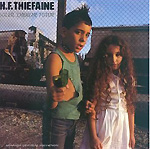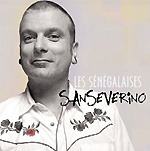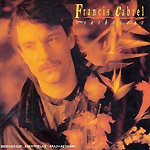Through The Lens of Maxime Ruiz
A Photographer's Guide to Music
Paris
03/11/2006 -

Maxime Ruiz is undoubtedly one of the most artistic and most multi-talented photographers to have emerged in the music world in recent years. Ruiz never covers concerts – "It's too tiring! There are too many restrictions! And why bother when Claude Gassian makes such a good job of it?" He has forged his reputation behind the scenes instead, capturing singers and musicians in their most intimate moments and paying painstaking attention to image, décor and detail as he captures the instant in flamboyant techni-colour, moody sepia or classic black and white.
Maxime Ruiz's photographs are not just simple visual records. Gaze long enough at them and they seem to tell a host of untold stories. Take the sublime portrait of Francis Cabrel on his latest album, Les beaux dégâts, for instance. The image of the singer at home, standing in the corner of a room, staring out of a window with his back turned to the camera. On the surface, the most banal everyday image – "not at all staged" claims Ruiz – which hints at Cabrel's simple, down-to-earth nature. But the image also somehow suggests that the singer is meditating on the "beaux dégâts" (beautiful damage) wreaked on his life and his career. Then there's the poetic portrait of the classical harpist Isabelle Moretti. Working with the tricks of digital technology, Ruiz portrays the musician with a giant blue butterfly in her arms – a colourful way of symbolising her instrument and breaking the austere image generally associated with classical musicians!
Born in Buenos Aires in 1950, the Argentinian maverick came to photography quite by chance. Ruiz grew up with two languages and two cultures thanks to his Argentinian director father and his French mother, who worked at the local French embassy. He studied at the Collège Français then, discovering a real passion for art, he went on to take classes at art college, then the Pan-American School of Art. In the '70s the young student's life changed dramatically when Buenos Aires got its first taste of the military junta which would eventually seize power in 1976. "That was an extremely violent period," Ruiz recalls, "Daily life revolved around raids by various secret police services, neighbours denouncing one another and soaring inflation… There didn't seem to be a future over there at all."
In 1974, Ruiz bailed out of Argentina and headed for France where he soon began a course in film studies at the Ecole Supérieure d'Etudes Cinématographiques (ESEC) in Paris. He graduated with a diploma but never made it onto a film set, moving on to work as a freelance graphic designer instead. Trying to make a bit of extra money on the side, he branched out into several different domains, working for advertising agencies and PR firms. "I worked with a lot of different photographers," he says, "but I was rarely satisfied with what they gave me so I started taking snapshots myself."
Reinventing Thiéfaine
 |
 |
 |
Ruiz basically taught himself the ropes, reading specialist photography magazines and swapping secrets and techniques with other professionals. As far as subject matter was concerned, he was instantly attracted to the music world. "I love listening to music," he says, "I'm really open to all kinds of musical styles and when I admire an artist and his work, I'm immediately inspired – even if the artist in question isn't a commercial success story!"
In 1982, Ruiz was responsible for creating the cover for Hubert-Felix Thiéfaine's album, Soleil cheche futur. "From that moment on," he recalls with some pride, "record stores moved Thiéfaine's albums from the folk section to the rock section!" Then, in 1989, Cabrel contacted Ruiz and asked him to illustrate his album Sarbacane. The pair have collaborated closely ever since, Ruiz creating a series of aesthetic booklets to accompany Cabrel's music and assuring all his photography needs as well as artistic direction. "It appears I’ve helped change his image from this sort of naïve, romantic singer aimed at young girls," quips Ruiz.
Around the same time, Ruiz resurrected the training from his ESEC days, working as a photography director and artistic producer on short "musical films" (notably Elsa's Jamais nous). These were the forerunners of the video clips which would be popularised by the French TV channel M6 when it started broadcasting in 1987. "Nothing was formatted like it is these days," recalls Ruiz, "video clips basically meant total freedom to explore whatever you wanted!" And this artistic liberty was precious to the self-taught photographer who has always refused to compromise his work. "I need to share a bond of affection with those I work for," he says. These lucky individuals have included Dominique Dalcan, the singer Skye, Didier Lockwood, Peter Kröner and the late Claude Nougaro (for whom Ruiz produced a 52-minute film in 1998 and created the album cover for Embarquement immédiat in 2000). More recently, he immortalised Sanseverino on the cover of Les Sénégalaises with a photograph taken in a studio set up in Ruiz's own living-room. "We shot it without any make-up or any other trappings after sitting down and enjoying this great meal where we really got to know one another!"
Sanseverino is an artist after his own heart, for Ruiz admits to being fed up with singers "who are so obsessed with their image that they'll make you spend a whole fortnight getting rid of every last wrinkle!" Staggered by what he calls the "sheer barbarity" of the music industry, Ruiz openly voices his dissatisfaction with a system where promotional photos and album covers are taken at the absolute worst moment, "when artists are exhausted after all the recording work and stressed out about the impending release." Ruiz remains convinced that a strong album cover still has the power to sway radio schedulers and record-buyers, although he admits that "these miniature visual identity cards" will eventually die out because of the Internet. Is the maverick photographer nostalgic for the good old days? "A little," he sighs, "I still use traditional silver print, you know, because I love getting that little knot of fear in the stomach while I wait for the final result."
Fleur de la Haye










